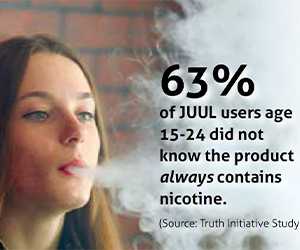
Vaping is so popular – and dangerous – for teens that the Surgeon General has declared youth use of e-cigarettes an epidemic.
Immediate health risks can be profound. In 2019, over 2,500 people were hospitalized with severe lung illness tied to vaping – many of them teens, and some requiring ventilators to breathe. There were 55 deaths in 2019; ages range from 17 to 75 years.
Symptoms include breathing difficulty, shortness of breath, and/or chest pain before hospitalization; some patients also had vomiting, diarrhea and fatigue. The Centers for Disease Control (CDC) and the Food & Drug Administration (FDA) continue to investigate cases in 27 states, including Minnesota. The FDA also is investigating reports of seizures and other neurological symptoms (fainting, tremors) from 2010 to 2019 that may be related to e-cigarettes.
Teen vaping is a disturbing trend after nearly 20 years of decline in nicotine addiction among teens. Now, youth are consuming nicotine in alarming numbers: 20% of high schoolers and 5% of middle schoolers have vaped in a given month, reports the Centers for Disease Control.
The main culprit is JUUL: the e-cigarette market leader has caused a 78% increase in vaping among high schoolers, reports the Centers for Disease Control. That puts a new generation at risk for serious injury – and for lifelong nicotine addiction.
Many kids don’t realize the risk. Flavors like Watermelon and Strawberry Lemonade treat nicotine like candy, rather than a highly addictive drug.
What is an e-cigarette? E-cigarettes (also called e-pens, e-hookahs, mods, vapes, tank systems) are battery-powered devices with a heating element that heats “e-liquid” from a cartridge, releasing a chemical-filled vapor. Not all e-cigarettes are created equal. JUUL is popular among youth because it’s particularly easy to conceal. The cartridges contain nicotine salts, which don’t produce as much vapor, and their sleek design resembles a USB drive – which is, in fact, how you charge it (see sidebar). JUUL cartridges contain as much nicotine as a pack of cigarettes.
What are other risks? First, nicotine addiction: the adolescent brain (up to age 25) is more vulnerable to nicotine than the adult brain, making the progression to nicotine addiction more likely. Fully 95% of adult smokers started before age 21. Using nicotine during adolescence affects mood, concentration, decision-making, and impulse control; long-term, it increases the risk of developing psychiatric disorders and cognitive impairment later in life. (Youth who vape are also more likely to go on to smoke traditional cigarettes.)
Second, e-liquids: There are over 7,000 e-cigarette flavors, and while these flavorings have been deemed safe by the FDA in food, studies are showing that when vaporized, the flavorings can cause cell damage to the blood vessels and lungs, leading to an increased risk for cardiovascular disease and irreversible lung damage.
What’s being done to help? Under the “Tobacco 21” national campaign, 485 cities and counties in 29 states (40 counties and cities in Minnesota) have increased the legal age to purchase e-cigarettes to 21 years. The goal: Prevent young people from ever starting. As of August 1, vaping = smoking in Minnesota under a new law that bans vaping in all public places where smoking is prohibited.
Is that “flash drive” an e-cigarette?
Warning signs of vaping among youth:
- Sweet or fruity smells
- Skipping their usual caffeinated drinks
- Increased thirst
- Nose bleeds
- Chronic cough
- Unfamiliar batteries or chargers
What parents can do:
- Talk to your kids early about the dangers of smoking and vaping
- Be a good example – maintain a tobacco-free home For help quitting, visit www.smokefree.gov
- Download the quitSTART app on your mobile device
- Youth wanting to quit can text QUIT to 47848 Call 1-800-QUIT-NOW (800-784-8669)
- Talk to your primary care provider for more resources
